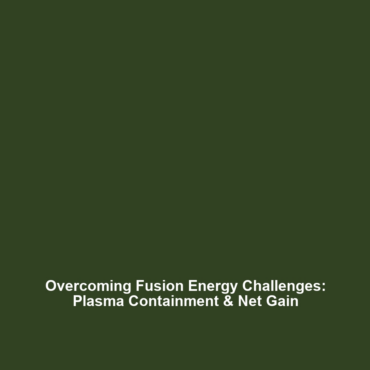Mission of the NIF: Inertial Confinement Fusion and Its Impact on Fusion Energy
Introduction
The National Ignition Facility (NIF) plays a pivotal role in the quest for sustainable fusion energy through its focus on inertial confinement fusion. By utilizing high-energy lasers to heat and compress micro fuel pellets, the NIF aims to achieve fusion ignition, a state where the energy produced from fusion reactions exceeds the energy input. This groundbreaking work is significant not just for energy production, but also for advancing scientific knowledge and addressing global energy demands.
Key Concepts
Inertial confinement fusion (ICF) is a process where powerful lasers are fired at small fuel pellets composed of deuterium and tritium, isotopes of hydrogen. The high energy from the lasers rapidly heats the outer layer of the pellet, causing it to implode and generate the extreme conditions necessary for fusion. Key concepts in this field include:
- Fusion Fuel: The primary fuel types used in ICF are deuterium and tritium.
- Laser Technology: NIF uses state-of-the-art laser systems to focus immense energy onto tiny targets.
- Fusion Conditions: Achieving the necessary temperature and pressure to enable fusion reactions is critical.
Understanding these concepts is crucial for appreciating the technical and scientific challenges associated with harnessing fusion energy.
Applications and Real-World Uses
The applications of inertial confinement fusion extend beyond energy generation. Some notable real-world uses include:
- Nuclear Research: The NIF provides insights into nuclear reactions and the behavior of matter under extreme conditions.
- National Security: The facility aids in the development of nuclear weapons and maintains the safety and reliability of the existing U.S. nuclear arsenal.
- Plasma Physics Studies: Research at the NIF contributes to the understanding of plasma physics, critical for advances in various fields from astrophysics to materials science.
These applications illustrate how inertial confinement fusion can influence a variety of sectors while pushing the boundaries of modern science.
Current Challenges
Despite its potential, inertial confinement fusion faces several challenges:
- Energy Input vs. Output: Achieving a net positive energy balance—where output energy exceeds input—is still elusive.
- Technological Limitations: The precision and energy required for successful ignition present significant engineering challenges.
- Research Funding: Continued investment in research and infrastructure is vital to advance ICF technologies.
Future Research and Innovations
Looking to the future, significant research innovations are anticipated in the realm of inertial confinement fusion. Innovations include:
- Advanced Laser Systems: Future laser technologies may provide improved efficiency and precision.
- Computation and Modelling: Enhanced computational models will allow for better simulations and understanding of fusion dynamics.
- International Collaboration: Increased collaboration between global research institutions may accelerate developments in fusion energy technology.
These advancements are vital for realizing the long-term vision of fusion as a sustainable energy source.
Conclusion
The mission of the National Ignition Facility underscores the significance of inertial confinement fusion in advancing fusion energy. Through its innovative use of powerful lasers and rigorous research, the NIF paves the way for potential breakthroughs that could revolutionize how we generate energy. Continued support for such initiatives is essential to unlock the future of clean, abundant energy. For further reading on fusion technologies and advancements, check out our articles on the latest fusion research and energy sustainability efforts.




